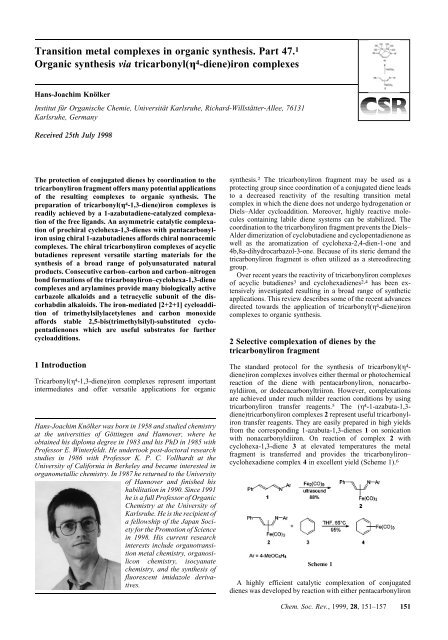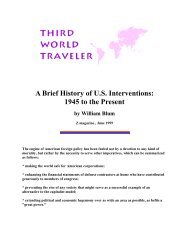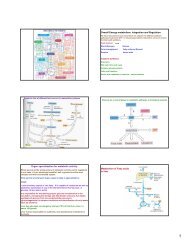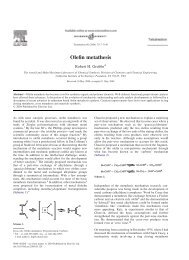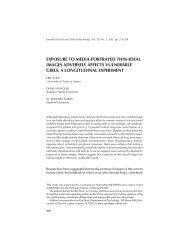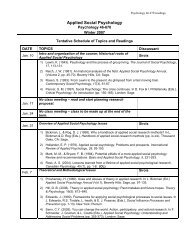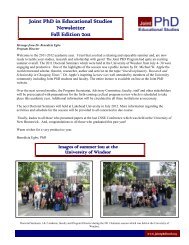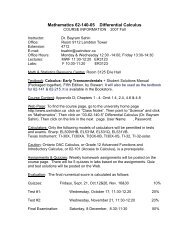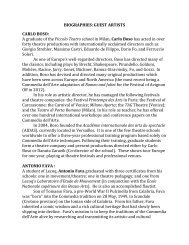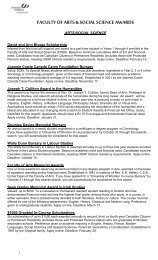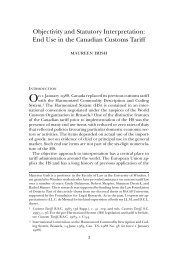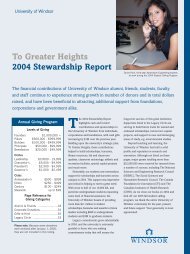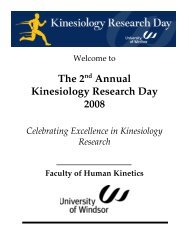Transition metal complexes in organic synthesis. Part 47
Transition metal complexes in organic synthesis. Part 47
Transition metal complexes in organic synthesis. Part 47
You also want an ePaper? Increase the reach of your titles
YUMPU automatically turns print PDFs into web optimized ePapers that Google loves.
<strong>Transition</strong> <strong>metal</strong> <strong>complexes</strong> <strong>in</strong> <strong>organic</strong> <strong>synthesis</strong>. <strong>Part</strong> <strong>47</strong>. 1<br />
Organic <strong>synthesis</strong> via tricarbonyl(h 4-diene)iron <strong>complexes</strong><br />
Hans-Joachim Knölker<br />
Institut für Organische Chemie, Universität Karlsruhe, Richard-Willstätter-Allee, 76131<br />
Karlsruhe, Germany<br />
Received 25th July 1998<br />
The protection of conjugated dienes by coord<strong>in</strong>ation to the<br />
tricarbonyliron fragment offers many potential applications<br />
of the result<strong>in</strong>g <strong>complexes</strong> to <strong>organic</strong> <strong>synthesis</strong>. The<br />
preparation of tricarbonyl(h 4-1,3-diene)iron <strong>complexes</strong> is<br />
readily achieved by a 1-azabutadiene-catalyzed complexation<br />
of the free ligands. An asymmetric catalytic complexation<br />
of prochiral cyclohexa-1,3-dienes with pentacarbonyliron<br />
us<strong>in</strong>g chiral 1-azabutadienes affords chiral nonracemic<br />
<strong>complexes</strong>. The chiral tricarbonyliron <strong>complexes</strong> of acyclic<br />
butadienes represent versatile start<strong>in</strong>g materials for the<br />
<strong>synthesis</strong> of a broad range of polyunsaturated natural<br />
products. Consecutive carbon–carbon and carbon–nitrogen<br />
bond formations of the tricarbonyliron–cyclohexa-1,3-diene<br />
<strong>complexes</strong> and arylam<strong>in</strong>es provide many biologically active<br />
carbazole alkaloids and a tetracyclic subunit of the discorhabd<strong>in</strong><br />
alkaloids. The iron-mediated [2+2+1] cycloaddition<br />
of trimethylsilylacetylenes and carbon monoxide<br />
affords stable 2,5-bis(trimethylsilyl)-substituted cyclopentadienones<br />
which are useful substrates for further<br />
cycloadditions.<br />
1 Introduction<br />
Tricarbonyl(h 4-1,3-diene)iron <strong>complexes</strong> represent important<br />
<strong>in</strong>termediates and offer versatile applications for <strong>organic</strong><br />
Hans-Joachim Knölker was born <strong>in</strong> 1958 and studied chemistry<br />
at the universities of Gött<strong>in</strong>gen and Hannover, where he<br />
obta<strong>in</strong>ed his diploma degree <strong>in</strong> 1983 and his PhD <strong>in</strong> 1985 with<br />
Professor E. W<strong>in</strong>terfeldt. He undertook post-doctoral research<br />
studies <strong>in</strong> 1986 with Professor K. P. C. Vollhardt at the<br />
University of California <strong>in</strong> Berkeley and became <strong>in</strong>terested <strong>in</strong><br />
organo<strong>metal</strong>lic chemistry. In 1987 he returned to the University<br />
of Hannover and f<strong>in</strong>ished his<br />
habilitation <strong>in</strong> 1990. S<strong>in</strong>ce 1991<br />
he is a full Professor of Organic<br />
Chemistry at the University of<br />
Karlsruhe. He is the recipient of<br />
a fellowship of the Japan Society<br />
for the Promotion of Science<br />
<strong>in</strong> 1998. His current research<br />
<strong>in</strong>terests <strong>in</strong>clude organotransition<br />
<strong>metal</strong> chemistry, organosilicon<br />
chemistry, isocyanate<br />
chemistry, and the <strong>synthesis</strong> of<br />
fluorescent imidazole derivatives.<br />
<strong>synthesis</strong>. 2 The tricarbonyliron fragment may be used as a<br />
protect<strong>in</strong>g group s<strong>in</strong>ce coord<strong>in</strong>ation of a conjugated diene leads<br />
to a decreased reactivity of the result<strong>in</strong>g transition <strong>metal</strong><br />
complex <strong>in</strong> which the diene does not undergo hydrogenation or<br />
Diels–Alder cycloaddition. Moreover, highly reactive molecules<br />
conta<strong>in</strong><strong>in</strong>g labile diene systems can be stabilized. The<br />
coord<strong>in</strong>ation to the tricarbonyliron fragment prevents the Diels–<br />
Alder dimerization of cyclobutadiene and cyclopentadienone as<br />
well as the aromatization of cyclohexa-2,4-dien-1-one and<br />
4b,8a-dihydrocarbazol-3-one. Because of its steric demand the<br />
tricarbonyliron fragment is often utilized as a stereodirect<strong>in</strong>g<br />
group.<br />
Over recent years the reactivity of tricarbonyliron <strong>complexes</strong><br />
of acyclic butadienes 3 and cyclohexadienes 2,4 has been extensively<br />
<strong>in</strong>vestigated result<strong>in</strong>g <strong>in</strong> a broad range of synthetic<br />
applications. This review describes some of the recent advances<br />
directed towards the application of tricarbonyl(h 4-diene)iron<br />
<strong>complexes</strong> to <strong>organic</strong> <strong>synthesis</strong>.<br />
2 Selective complexation of dienes by the<br />
tricarbonyliron fragment<br />
The standard protocol for the <strong>synthesis</strong> of tricarbonyl(h 4diene)iron<br />
<strong>complexes</strong> <strong>in</strong>volves either thermal or photochemical<br />
reaction of the diene with pentacarbonyliron, nonacarbonyldiiron,<br />
or dodecacarbonyltriiron. However, complexations<br />
are achieved under much milder reaction conditions by us<strong>in</strong>g<br />
tricarbonyliron transfer reagents. 5 The (h 4-1-azabuta-1,3diene)tricarbonyliron<br />
<strong>complexes</strong> 2 represent useful tricarbonyliron<br />
transfer reagents. They are easily prepared <strong>in</strong> high yields<br />
from the correspond<strong>in</strong>g 1-azabuta-1,3-dienes 1 on sonication<br />
with nonacarbonyldiiron. On reaction of complex 2 with<br />
cyclohexa-1,3-diene 3 at elevated temperatures the <strong>metal</strong><br />
fragment is transferred and provides the tricarbonyliron–<br />
cyclohexadiene complex 4 <strong>in</strong> excellent yield (Scheme 1). 6<br />
Scheme 1<br />
A highly efficient catalytic complexation of conjugated<br />
dienes was developed by reaction with either pentacarbonyliron<br />
Chem. Soc. Rev., 1999, 28, 151–157 151
or nonacarbonyldiiron <strong>in</strong> the presence of the 1-azabuta-<br />
1,3-diene 1. Thus, the 1-azabuta-1,3-diene-catalyzed complexation<br />
of cyclohexa-1,3-diene 3 with pentacarbonyliron affords<br />
complex 4 quantitatively (Scheme 2). 7<br />
Scheme 2<br />
The catalytic complexation of cyclohexadiene 3 is proposed<br />
to be <strong>in</strong>itiated by a nucleophilic attack of the im<strong>in</strong>e nitrogen of<br />
the 1-azabutadiene 1 at one of the carbonyl ligands of<br />
pentacarbonyliron (Scheme 3). 7 Loss of carbon monoxide by<br />
<strong>in</strong>ternal ligand displacement transforms the result<strong>in</strong>g (carbamoyl)tetracarbonyliron<br />
complex 5 <strong>in</strong>to the (h 3-allyl) (carbamoyl)tricarbonyliron<br />
complex 6. Complex 6 isomerizes by<br />
haptotropic migration of the tetracarbonyliron fragment first to<br />
the (h 2-olef<strong>in</strong>)tetracarbonyliron complex 7 and then to the (h 1im<strong>in</strong>e)tetracarbonyliron<br />
complex 8. Further loss of a carbonyl<br />
ligand from 8 generates the (h 1-im<strong>in</strong>e)tricarbonyliron complex<br />
9, which is <strong>in</strong> equilibrium with the stable (h 4-1-azabutadiene)tricarbonyliron<br />
complex 2 (cf. Scheme 1) by haptotropic<br />
migration of the tricarbonyliron fragment. Reaction of the<br />
tricarbonyliron complex 2 with excess pentacarbonyliron leads<br />
to the hexacarbonyldiiron complex 11, which was structurally<br />
confirmed by X-ray analysis. 7 The vacant coord<strong>in</strong>ation site of<br />
the crucial 16-electron <strong>in</strong>termediate 9 may be filled by h 2coord<strong>in</strong>ation<br />
of cyclohexadiene 3 to provide complex 10. Loss<br />
of the 1-azabutadiene regenerates the catalyst 1 and haptotropic<br />
(h 2 ? h 4) migration of the tricarbonyliron fragment affords<br />
complex 4.<br />
Optically active planar chiral tricarbonyliron–diene <strong>complexes</strong><br />
can be obta<strong>in</strong>ed directly by catalytic asymmetric<br />
complexation of the correspond<strong>in</strong>g prochiral ligands with the<br />
transition <strong>metal</strong> fragment. Us<strong>in</strong>g chiral 1-azabuta-1,3-dienes <strong>in</strong><br />
the catalytic complexation described above an enantioselective<br />
coord<strong>in</strong>ation of prochiral 1,3-dienes to the tricarbonyliron<br />
fragment with useful asymmetric <strong>in</strong>ductions was achieved. 8<br />
Catalytic complexation of 1-methoxycyclohexa-1,3-diene (12)<br />
with pentacarbonyliron us<strong>in</strong>g the (R)-camphor-derived 1-azadiene<br />
(R)-13 afforded the tricarbonyliron complex (S)-14, while<br />
catalyst (S)-13 led to complex (R)-14 (Scheme 4).<br />
Current research <strong>in</strong> this area focusses on the development of<br />
more efficient chiral catalysts useful for the asymmetric<br />
152 Chem. Soc. Rev., 1999, 28, 151–157<br />
Scheme 3<br />
Scheme 4<br />
catalytic complexation of a broad range of prochiral buta-<br />
1,3-diene and cycloalka-1,3-diene ligands. Thus, this method<br />
should facilitate the access to chiral nonracemic tricarbonyliron–diene<br />
<strong>complexes</strong> as start<strong>in</strong>g materials for enantioselective<br />
<strong>organic</strong> <strong>synthesis</strong>.<br />
3 Applications of tricarbonyliron–butadiene<br />
<strong>complexes</strong><br />
Acyclic tricarbonyliron–butadiene <strong>complexes</strong> represent useful<br />
start<strong>in</strong>g materials for the <strong>synthesis</strong> of acyclic polyunsaturated<br />
natural products, e.g. the metabolites result<strong>in</strong>g from the<br />
5-lipoxygenase pathway of the arachidonic acid cascade. 3<br />
The stereoselective Friedel–Crafts acylation of tricarbonyliron–butadiene<br />
<strong>complexes</strong> <strong>in</strong>itially affords the Z-dienones,<br />
which on acid-catalyzed isomerization provide the thermodynamically<br />
more stable E-dienones. 9 This method was applied to<br />
an enantioselective total <strong>synthesis</strong> of the natural leukotriene<br />
(2)-5(S),6(S)-LTA4 methyl ester (18) (Scheme 5). 10 Friedel–<br />
Crafts acylation of the enantiopure iron complex of trans-penta-<br />
2,4-dienoic 2,2,2-trichloroethyl ester 15 us<strong>in</strong>g the acid chloride<br />
of adipic acid monomethyl ester afforded complex 17 which<br />
was subsequently converted to the LTA4 methyl ester 18.<br />
The planar chiral complex tricarbonyl[h 4-methyl (2E,4E)-<br />
6-oxohexa-2,4-dienoate]iron (19) is easily separated <strong>in</strong>to the<br />
enantiomers by resolution with ephedr<strong>in</strong>e. 11,12 Start<strong>in</strong>g from<br />
this chiral build<strong>in</strong>g block an eight-step enantioselective total
Scheme 5<br />
<strong>synthesis</strong> of 5(R)-hydroxyeicosatetraenoic acid (HETE) methyl<br />
ester (23) was recently accomplished (Scheme 6). 12 Borohydride<br />
reduction of the (2)-complex 19 followed by treatment of<br />
the <strong>in</strong>termediate alcohol 20 with hexafluorophosphoric acid<br />
Scheme 6<br />
afforded the enantiopure 1(R)-tricarbonyl[1-(methoxycarbonyl)pentadienylium]iron<br />
hexafluorophosphate 21. Addition of<br />
the organocuprate prepared from deca-1,4-diyne occurred with<br />
complete regioselectivity and provided the 2(R)-methyl<br />
(2E,4Z)-hexadeca-2,4-diene-7,10-diynoate complex 22. The<br />
next steps <strong>in</strong>volve conversion to the (7Z,10Z)-diene system by<br />
stereoselective hydrogenation us<strong>in</strong>g L<strong>in</strong>dlar catalyst, transformation<br />
of the ester function <strong>in</strong>to the aldehyde by DIBAL<br />
reduction followed by oxidation with manganese dioxide, and<br />
nucleophilic addition of a C4-build<strong>in</strong>g block conta<strong>in</strong><strong>in</strong>g a<br />
protected ester function (2 : 1 stereoselectivity). The <strong>synthesis</strong><br />
of 5(R)-HETE methyl ester 23 was completed by de<strong>metal</strong>lation<br />
of the complex us<strong>in</strong>g ceric ammonium nitrate. Current applications<br />
of the iron-complexed methyl (2E,4E)-6-oxo-hexa-<br />
2,4-dienoate 19 focus on the enantioselective total <strong>synthesis</strong> of<br />
macrolact<strong>in</strong> A. 13,14<br />
Scheme 7<br />
The first asymmetric <strong>synthesis</strong> of the piperid<strong>in</strong>e alkaloid<br />
SS20846A (27) was achieved by a diastereoselective lithium<br />
perchlorate-promoted cycloaddition of the enantiopure tricarbonyliron-complexed<br />
1-azatriene 24 with Danishefsky’s diene 25<br />
(Scheme 7). 15 The result<strong>in</strong>g enone 26 was reduced to the<br />
saturated alcohol. The f<strong>in</strong>al oxidation us<strong>in</strong>g ceric ammonium<br />
nitrate resulted <strong>in</strong> simultaneous de<strong>metal</strong>lation of the butadiene<br />
moiety and deprotection of the nitrogen atom.<br />
4 Applications of tricarbonyliron–cyclohexadiene<br />
<strong>complexes</strong><br />
The most characteristic feature of tricarbonyl(h 4-1,3-diene)iron<br />
<strong>complexes</strong> is the activation of the allylic C–H bonds which<br />
enables hydride abstraction by triphenylmethyl tetrafluoroborate.<br />
Thus, cyclohexa-1,3-diene (3) is transformed via the<br />
tricarbonyliron complex 4 to the tricarbonyl(h 5-cyclohexadienylium)iron<br />
tetrafluoroborate (28). For steric reasons the<br />
bulky tricarbonyliron fragment of the <strong>metal</strong>-coord<strong>in</strong>ated cation<br />
exhibits a strong stereodirect<strong>in</strong>g effect, which on reaction with<br />
nucleophiles results <strong>in</strong> an approach of the reagent from the face<br />
opposite to the iron (anti selectivity). Therefore, reaction of the<br />
complex salt 28 with appropriate nucleophiles provides the<br />
5-anti-substituted tricarbonyl(h 4-cyclohexa-1,3-diene)iron<br />
<strong>complexes</strong> 29 by regio- and stereoselective formation of<br />
carbon–carbon or carbon–heteroatom bonds. De<strong>metal</strong>lation of<br />
the <strong>complexes</strong> 29 us<strong>in</strong>g trimethylam<strong>in</strong>e N-oxide affords the free<br />
dienes 30 which are substituted <strong>in</strong> the allylic position (Scheme<br />
8). Because of the high degree of regio- and stereoselectivity <strong>in</strong><br />
bond form<strong>in</strong>g reactions at the coord<strong>in</strong>ated ligand this chemistry<br />
has found diverse applications <strong>in</strong> synthetic <strong>organic</strong> chemistry<br />
<strong>in</strong>clud<strong>in</strong>g natural product <strong>synthesis</strong>. 2,4<br />
Scheme 8<br />
4.1 Total <strong>synthesis</strong> of carbazole alkaloids<br />
Over the past two decades a broad range of carbazole alkaloids<br />
with useful biological activities were isolated from diverse<br />
natural sources. 16 A highly convergent access to these natural<br />
products was developed based on consecutive iron-mediated C–<br />
C and C–N bond formation. 17 The tricarbonyliron-complexed<br />
cyclohexadienyl cations represent very efficient reagents for the<br />
electrophilic aromatic substitution of arylam<strong>in</strong>es. 18 Oxidative<br />
cyclization of the result<strong>in</strong>g arylam<strong>in</strong>e-substituted tricarbonyl(h<br />
4-cyclohexa-1,3-diene)iron <strong>complexes</strong> provides carbazoles.<br />
Different techniques for the oxidative cyclization to<br />
carbazole derivatives were elaborated depend<strong>in</strong>g on the substitution<br />
pattern of the arylam<strong>in</strong>e.<br />
The oxidative cyclization of arylam<strong>in</strong>e-substituted tricarbonyl(h<br />
4-cyclohexa-1,3-diene)iron <strong>complexes</strong> to the 9H-carbazoles<br />
can be performed as a one-pot transformation with<br />
concomitant aromatization and de<strong>metal</strong>lation by us<strong>in</strong>g very<br />
active manganese dioxide (iron-mediated arylam<strong>in</strong>e cyclization).<br />
An application of this method was shown by the five-step<br />
<strong>synthesis</strong> of the antibiotic carbazomyc<strong>in</strong>s G and H. 19 These<br />
Chem. Soc. Rev., 1999, 28, 151–157 153
novel carbazole alkaloids isolated from Streptoverticillium<br />
ehimense are structurally unique because of the qu<strong>in</strong>ol moiety.<br />
The electrophilic substitution of the arylam<strong>in</strong>e 31 with the<br />
complex salt 28 to the iron complex 32 demonstrates that even<br />
hexasubstituted arylam<strong>in</strong>es can be generated <strong>in</strong> this transformation<br />
(Scheme 9). After protection by chemoselective O-<br />
Scheme 9<br />
acetylation an iron-mediated arylam<strong>in</strong>e cyclization to the<br />
carbazole 33 was achieved by treatment with very active<br />
manganese dioxide. Oxidation of 33 with ceric ammonium<br />
nitrate (CAN) to the qu<strong>in</strong>one and subsequent addition of<br />
methyllithium afforded carbazomyc<strong>in</strong> G (34). Start<strong>in</strong>g from the<br />
3-methoxy-substituted complex salt carbazomyc<strong>in</strong> H became<br />
available follow<strong>in</strong>g the same reaction sequence.<br />
The iron-mediated arylam<strong>in</strong>e cyclization with concomitant<br />
aromatization was recently also applied to the total <strong>synthesis</strong> of<br />
the mar<strong>in</strong>e natural product hyellazole, 20 the furo[3,2-a]carbazole<br />
alkaloid furostifol<strong>in</strong>e, 21 and the 5-lipoxygenase <strong>in</strong>hibitor<br />
carbazomyc<strong>in</strong> C. 22<br />
An extension of this methodology us<strong>in</strong>g a two-directional<br />
<strong>synthesis</strong> by simultaneous annulation of two <strong>in</strong>dole units at a<br />
central phenylenediam<strong>in</strong>e opens up a simple two-step route to<br />
<strong>in</strong>dolocarbazoles (Scheme 10). 23 Two-fold electrophilic substitution<br />
of commercial m-phenylenediam<strong>in</strong>e (35) by reaction<br />
with 2.2 equivalents of the complex salt 28 afforded the<br />
d<strong>in</strong>uclear iron complex 36. Double iron-mediated arylam<strong>in</strong>e<br />
cyclization of 36 by oxidation with an excess of iod<strong>in</strong>e <strong>in</strong><br />
pyrid<strong>in</strong>e provided <strong>in</strong>dolo[2,3-b]carbazole (37).<br />
Scheme 10<br />
An alternative procedure for oxidative cyclization of the<br />
arylam<strong>in</strong>e-substituted tricarbonyl(h 4-cyclohexa-1,3-diene)iron<br />
<strong>complexes</strong> is the iron-mediated qu<strong>in</strong>one–im<strong>in</strong>e cyclization. 24<br />
Application of this procedure to the total <strong>synthesis</strong> of the<br />
antibiotic carbazomyc<strong>in</strong> D required a regioselective cyclization<br />
at an unsymmetrically substituted cyclohexadiene ligand<br />
(Scheme 11). 22 Reaction of the 3-methoxy-substituted complex<br />
salt 38 with the arylam<strong>in</strong>e 39 provided the iron complex 40.<br />
Chemoselective oxidation of the aromatic nucleus to the<br />
qu<strong>in</strong>one im<strong>in</strong>e followed by oxidative cyclization gave the<br />
tricarbonyliron-complexed 6-methoxy-substituted 4b,8a-dihy-<br />
154 Chem. Soc. Rev., 1999, 28, 151–157<br />
Scheme 11<br />
drocarbazol-3-one 41. The regioselectivity of this oxidative<br />
cyclization could be rationalized by previous studies us<strong>in</strong>g<br />
deuterium-labelled cyclohexadiene ligands. 25 Treatment with<br />
manganese dioxide as a two-electron oxidant <strong>in</strong>itially leads to<br />
cyclization by exclusive attack of the am<strong>in</strong>o group at C-4 of the<br />
cyclohexadiene ligand. The proton-catalyzed rearrangement of<br />
this k<strong>in</strong>etic product, the 8-methoxy isomer, leads to the<br />
6-methoxy isomer 41 and is controlled by the regio-direct<strong>in</strong>g<br />
effect of the 2-methoxy substituent of the <strong>in</strong>termediate ironcomplexed<br />
cyclohexadienyl cation. De<strong>metal</strong>lation of complex<br />
41 and subsequent O-methylation of the <strong>in</strong>termediate 3hydroxycarbazole<br />
provided carbazomyc<strong>in</strong> D (42). 22<br />
The iron-mediated qu<strong>in</strong>one–im<strong>in</strong>e cyclization is of broad<br />
scope and currently provides the best route to 3-hydroxycarbazole<br />
alkaloids. 24 Further recent applications of this method<br />
<strong>in</strong> the total <strong>synthesis</strong> of biologically active carbazole alkaloids<br />
<strong>in</strong>clude the mar<strong>in</strong>e alkaloid hyellazole 20 and the free radical<br />
scavenger carazostat<strong>in</strong>. 26<br />
Scheme 12<br />
More recently, a third method for oxidative cyclization of the<br />
arylam<strong>in</strong>e-substituted tricarbonyliron–cyclohexadiene <strong>complexes</strong><br />
to the carbazole framework was developed. Oxidation of<br />
the iron <strong>complexes</strong> <strong>in</strong> acidic medium by molecular oxygen<br />
provides selectively the tricarbonyliron-complexed 4a,9a-dihydro-9H-carbazole<br />
derivatives. The first <strong>synthesis</strong> of mukonid<strong>in</strong>e
was accomplished by this method. 27 The electrophilic substitution<br />
of the arylam<strong>in</strong>e by the iron-complexed cyclohexadienyl<br />
cation can be comb<strong>in</strong>ed with the oxidative cyclization <strong>in</strong> the air,<br />
thus provid<strong>in</strong>g access to the carbazole skeleton <strong>in</strong> a one-pot<br />
process. This novel construction of the carbazole framework<br />
was applied to the total syntheses of the potent neuronal cell<br />
protect<strong>in</strong>g substances (±)-carqu<strong>in</strong>ostat<strong>in</strong> A (46) 28 and (±)-lavanduqu<strong>in</strong>oc<strong>in</strong><br />
(<strong>47</strong>) 29 isolated by Seto et al. from Streptomyces<br />
(Scheme 12). The reaction of the arylam<strong>in</strong>e 43 with the complex<br />
salt 28 <strong>in</strong> the air for 7 days at room temperature provided with<br />
concomitant oxidative cyclization the tricarbonyliron-complexed<br />
4a,9a-dihydro-9H-carbazole 44. De<strong>metal</strong>lation of complex<br />
44 followed by dehydrogenation and electrophilic brom<strong>in</strong>ation<br />
afforded the bromocarbazole 45 which represents a<br />
crucial precursor for the total <strong>synthesis</strong> of 6-allyl-substituted<br />
carbazole-3,4-qu<strong>in</strong>one alkaloids. A nickel-mediated coupl<strong>in</strong>g<br />
with prenyl bromide (for 46) 28 or with b-cyclolavandulyl<br />
bromide (for <strong>47</strong>) 29 respectively, followed by cleavage of<br />
the acetate and oxidation with CAN afforded the natural<br />
products.<br />
The one-pot construction of the carbazole framework was<br />
also used for the first total syntheses of the potent lipid<br />
peroxidation <strong>in</strong>hibitor carbazoqu<strong>in</strong>oc<strong>in</strong> C 30 and the free radical<br />
scavenger (±)-neocarazostat<strong>in</strong> B. 31<br />
4.2 Diastereoselective spiroannulations<br />
The addition of nucleophiles to tricarbonyl(h 5-1-alkyl-<br />
4-methoxycyclohexadienyl)iron cations offers a simple method<br />
for the stereoselective generation of quaternary carbon centers.<br />
The observed selectivity is a consequence of the regiodirect<strong>in</strong>g<br />
effect of the methoxy-substituent, which directs the <strong>in</strong>com<strong>in</strong>g<br />
nucleophile to the 1-position (para selectivity), and the<br />
stereodirect<strong>in</strong>g effect of the tricarbonyliron moiety, which<br />
enforces an attack of the nucleophile from the face opposite to<br />
the transition <strong>metal</strong> (anti selectivity). 2,4 Based on this chemistry<br />
a diastereoselective one-pot annulation of different spiroqu<strong>in</strong>ol<strong>in</strong>e<br />
r<strong>in</strong>g systems was developed by reaction of the iron complex<br />
salt 48 with arylam<strong>in</strong>es. 4 The complex salt 48 is readily<br />
prepared <strong>in</strong> 50–60% overall yield start<strong>in</strong>g from p-methoxyphenylacetic<br />
acid by the follow<strong>in</strong>g simple six-step sequence: 1.<br />
Birch reduction, 2. esterification, 3. complexation with pentacarbonyliron,<br />
4. DIBAL reduction, 5. acylation with pnitrobenzoylchloride,<br />
and 6. hydride abstraction us<strong>in</strong>g triphenylmethyl<br />
tetrafluoroborate. The cyclohexadienyl cation of 48<br />
represents a 1,3-double acceptor, s<strong>in</strong>ce it has a leav<strong>in</strong>g group at<br />
a C2-side cha<strong>in</strong> <strong>in</strong> the 1-position. Therefore, stereoselective<br />
construction of a quarternary carbon by regioselective electrophilic<br />
aromatic substitution at the o-am<strong>in</strong>o position of the<br />
arylam<strong>in</strong>e and subsequent cyclization via nucleophilic displacement<br />
of the p-nitrobenzoate by the am<strong>in</strong>o group provide directly<br />
benzo-annulated 3-azaspiro[5.5]undecanes. 4<br />
The iron-mediated spiroannulation was used for a synthetic<br />
approach to the discorhabd<strong>in</strong> alkaloids. 32 The discorhabd<strong>in</strong>s are<br />
the major cytotoxic pigments isolated from mar<strong>in</strong>e sponges of<br />
the genus Latrunculia. They conta<strong>in</strong> an unprecedented pyrrolo-<br />
[1,7]phenanthrol<strong>in</strong>e framework with a spiroannulated cyclohexenone<br />
r<strong>in</strong>g and exhibit strong cytotoxic and antimicrobial<br />
activities. Reaction of the iron complex salt 48 with 1-acetyl-<br />
6-am<strong>in</strong>o-4,7-dimethoxy<strong>in</strong>dol<strong>in</strong>e (49) at 230 °C afforded diastereoselectively<br />
the spirocyclic iron complex 50 <strong>in</strong> 72% yield<br />
(Scheme 13). N-Acylation of complex 50 followed by de<strong>metal</strong>lation<br />
with trimethylam<strong>in</strong>e N-oxide and hydrolysis of the enol<br />
ether provided the spirocyclohexenone 51. This product<br />
represents a functionalized tetracyclic substructure of the<br />
discorhabd<strong>in</strong>s and appears to be a promis<strong>in</strong>g precursor for a<br />
projected total <strong>synthesis</strong> of discorhabd<strong>in</strong> C (52).<br />
The stereodirect<strong>in</strong>g effect of the tricarbonyliron fragment<br />
lead<strong>in</strong>g to an attack of the nucleophile at the cyclohexadienyl<br />
Scheme 13<br />
cation exclusively from the face anti to the <strong>metal</strong> (anti<br />
selectivity) strongly applies only under k<strong>in</strong>etic reaction conditions.<br />
Us<strong>in</strong>g thermodynamic reaction conditions for the spirocyclization<br />
step, the attack of the nucleophile syn to the<br />
tricarbonyliron fragment becomes feasible. This reversal of<br />
stereoselectivity was demonstrated for the spirolactonization of<br />
the complex salt 53 result<strong>in</strong>g <strong>in</strong> 3 steps from p-methoxyc<strong>in</strong>namic<br />
acid. Cleavage of the ester under acidic conditions and<br />
subsequent base-<strong>in</strong>duced cyclization at room temperature<br />
stereospecifically provided the spirolactone anti-54 result<strong>in</strong>g<br />
from approach of the carboxylate ion anti relative to the<br />
tricarbonyliron fragment (Scheme 14). However, application of<br />
thermodynamic reaction conditions by reflux<strong>in</strong>g complex anti-<br />
54 with triethylammonium hexafluorophosphate <strong>in</strong> acetonitrile<br />
afforded the diastereoisomeric spirolactone <strong>complexes</strong> anti-54<br />
and syn-54 <strong>in</strong> a ratio of 1.8 : 1 as the thermodynamic<br />
mixture. 33<br />
Scheme 14<br />
5 Synthesis of cyclopentadienones<br />
The thermal reaction of pentacarbonyliron with alkynes provides<br />
tricarbonyl(h 4-cyclopentadienone)iron <strong>complexes</strong>. 34 This<br />
iron-mediated formal [2+2+1] cycloaddition of two alkynes and<br />
carbon monoxide was recently re<strong>in</strong>vestigated. 35239 Cycloaddition<br />
of pentacarbonyliron and two equivalents of trimethylsilylacetylene<br />
(55) at 140 °C <strong>in</strong> a sealed tube provided the<br />
tricarbonyliron complex of 2,5-bis(trimethylsilyl)cyclopentadienone<br />
(56) as a s<strong>in</strong>gle regioisomer (Scheme 15). 35<br />
Chem. Soc. Rev., 1999, 28, 151–157 155
Scheme 15<br />
The bicyclization of the diynes 57 and carbon monoxide by<br />
iron-mediated [2+2+1] cycloaddition afforded the tricarbonyliron-complexed<br />
bicyclo[n.3.0]alkanones 58 (Scheme 16). Vari-<br />
Scheme 16<br />
ation of the diyne precursor provided a broad range of carboand<br />
heterobicyclic r<strong>in</strong>g systems. 37 The de<strong>metal</strong>lation of the<br />
bicyclic tricarbonyliron(h 4-cyclopentadienone)iron <strong>complexes</strong><br />
at low temperature afforded the correspond<strong>in</strong>g cyclopentadienones<br />
59. At higher temperatures a subsequent double bond<br />
isomerization with concomitant monoprotodesilylation provided<br />
the dienones 60. 37 These compounds are potential double<br />
Michael acceptors and promise useful applications to the<br />
<strong>synthesis</strong> of cyclopentanoid natural products.<br />
Scheme 17<br />
Although protected aga<strong>in</strong>st Diels–Alder dimerization for<br />
steric reasons by the two bulky trimethylsilyl substitutents the<br />
bicyclic cyclopentadienones 59 represent highly reactive dienes<br />
for Diels–Alder cycloadditions with appropriate dienophiles.<br />
The Diels–Alder reaction of the bicyclic cyclopentadienone 59b<br />
with p-benzoqu<strong>in</strong>one 61 afforded stereoselectively the endocycloadduct<br />
62 (Scheme 17). A subsequent photochemically<br />
<strong>in</strong>itiated <strong>in</strong>tramolecular [2+2] cycloaddition provided quantitatively<br />
the hexacyclic cage compound 63. 40<br />
156 Chem. Soc. Rev., 1999, 28, 151–157<br />
6 Conclusion<br />
The 1-azabutadiene catalyzed complexation of dienes with<br />
pentacarbonyliron represents a very efficient procedure for the<br />
<strong>synthesis</strong> of tricarbonyliron–diene <strong>complexes</strong>. Chiral 1-azabutadienes<br />
were used for the asymmetric catalytic complexation of<br />
prochiral diene ligands provid<strong>in</strong>g optically active planar chiral<br />
tricarbonyliron <strong>complexes</strong>. Many enantioselective syntheses of<br />
polyunsaturated natural products were elaborated start<strong>in</strong>g from<br />
chiral acyclic tricarbonyliron–butadiene <strong>complexes</strong>. Convergent<br />
routes to different natural product frameworks are provided<br />
by the tricarbonyliron-mediated annulation of cyclohexadienes<br />
and arylam<strong>in</strong>es. The iron-mediated <strong>synthesis</strong> of carbazoles<br />
currently represents the best access to biologically active highly<br />
substituted carbazole alkaloids isolated from different Streptomyces<br />
species over the past years. A one-pot construction of the<br />
carbazole framework was achieved by oxidative cyclization <strong>in</strong><br />
the air and applied to a short and simple route to carbazole-<br />
3,4-qu<strong>in</strong>one alkaloids. The diastereoselective iron-mediated<br />
spiroannulation of arylam<strong>in</strong>es provided a one-pot access to<br />
spiroqu<strong>in</strong>ol<strong>in</strong>e derivatives related to the cytotoxic discorhabd<strong>in</strong><br />
alkaloids. The iron-mediated [2+2+1] cycloaddition of term<strong>in</strong>ally<br />
silylated alkynes and carbon monoxide afforded the<br />
tricarbonyliron <strong>complexes</strong> of 2,5-disilylcyclopentadienones.<br />
Their free ligands are useful dienes for subsequent cycloadditions<br />
to highly substituted cage compounds.<br />
7 Acknowledgements<br />
I wish to thank my coworkers who contributed to this project<br />
and whose names are given <strong>in</strong> the correspond<strong>in</strong>g references. We<br />
are grateful to the Deutsche Forschungsgeme<strong>in</strong>schaft, the<br />
Volkswagen Foundation, the Fonds der Chemischen Industrie,<br />
and the Alexander von Humboldt Foundation for their f<strong>in</strong>ancial<br />
support of our work.<br />
8 References<br />
1 <strong>Part</strong> 46: H.-J. Knölker, M. Graf and U. Mangei, J. Prakt. Chem., 1998,<br />
340, 530.<br />
2 A. J. Pearson, Iron Compounds <strong>in</strong> Organic Synthesis, Academic Press,<br />
London, 1994, chap. 4 and 5; and references cited there<strong>in</strong>.<br />
3 R. Grée and J. P. Lellouche, <strong>in</strong> Advances <strong>in</strong> Metal-Organic Chemistry,<br />
ed. L. S. Liebesk<strong>in</strong>d, JAI Press, Greenwich (CT), 1995, vol. 4, p. 129;<br />
and references cited there<strong>in</strong>.<br />
4 H.-J. Knölker, Synlett, 1992, 371; and references cited there<strong>in</strong>.<br />
5 H.-J. Knölker, <strong>in</strong> Encyclopedia of Reagents for Organic Synthesis, ed.<br />
L. A. Paquette, Wiley, Chichester, 1995, vol. 1, p. 333; and references<br />
cited there<strong>in</strong>.<br />
6 H.-J. Knölker, G. Baum, N. Foitzik, H. Goesmann, P. Gonser, P. G.<br />
Jones and H. Röttele, Eur. J. Inorg. Chem., 1998, 993.<br />
7 H.-J. Knölker, E. Baum, P. Gonser, G. Rohde and H. Röttele,<br />
Organo<strong>metal</strong>lics, 1998, 17, 3916.<br />
8 H.-J. Knölker and H. Hermann, Angew. Chem., 1996, 108, 363; Angew.<br />
Chem., Int. Ed. Engl., 1996, 35, 341.<br />
9 M. Franck-Neumann, M. Sedrati and M. Mokhi, Angew. Chem., 1986,<br />
98, 1138; Angew. Chem., Int. Ed. Engl., 1986, 25, 1131.<br />
10 M. Franck-Neumann and P.-J. Colson, Synlett, 1991, 891.<br />
11 A. Monpert, J. Martelli, R. Grée and R. Carrié, Tetrahedron Lett., 1981,<br />
22, 1961.<br />
12 C. Tao and W. A. Donaldson, J. Org. Chem., 1993, 58, 2134.<br />
13 W. A. Donaldson, P. T. Bell, Z. Wang and D. W. Bennett, Tetrahedron<br />
Lett., 1994, 32, 5892; V. Prahlad and W. A. Donaldson, Tetrahedron<br />
Lett., 1996, 37, 9169.<br />
14 T. J. Benvegnu, L. J. Toupet and R. Grée, Tetrahedron, 1996, 52, 11811;<br />
T. J. Benvegnu and R. Grée, Tetrahedron, 1996, 52, 11821.<br />
15 C. Iwata and Y. Takemoto, Chem. Commun., 1996, 2497; and references<br />
cited there<strong>in</strong>.<br />
16 D. P. Chakraborty, <strong>in</strong> The Alkaloids, ed. A. Brossi, Academic Press,<br />
New York, 1993, vol. 44, p. 257; and references cited there<strong>in</strong>.
17 H.-J. Knölker, <strong>in</strong> Advances <strong>in</strong> Nitrogen Heterocycles, ed. C. J. Moody,<br />
JAI Press, Greenwich (CT), 1995, vol. 1, p. 173; and references cited<br />
there<strong>in</strong>.<br />
18 H.-J. Knölker, M. Bauermeister and J.-B. Pannek, Chem. Ber., 1992,<br />
125, 2783.<br />
19 H.-J. Knölker and W. Fröhner, Tetrahedron Lett., 1997, 38, 4051.<br />
20 H.-J. Knölker, E. Baum and T. Hopfmann, Tetrahedron Lett., 1995, 36,<br />
5339.<br />
21 H.-J. Knölker and W. Fröhner, Tetrahedron Lett., 1996, 37, 9183.<br />
22 H.-J. Knölker and G. Schlecht<strong>in</strong>gen, J. Chem. Soc., Perk<strong>in</strong> Trans. 1,<br />
1997, 349.<br />
23 H.-J. Knölker and K. R. Reddy, Tetrahedron Lett., 1998, 39, 4007.<br />
24 H.-J. Knölker, M. Bauermeister, J.-B. Pannek and M. Wolpert,<br />
Synthesis, 1995, 397.<br />
25 H.-J. Knölker, F. Budei, J.-B. Pannek and G. Schlecht<strong>in</strong>gen, Synlett,<br />
1996, 587.<br />
26 H.-J. Knölker and T. Hopfmann, Synlett, 1995, 981.<br />
27 H.-J. Knölker and M. Wolpert, Tetrahedron Lett., 1997, 38, 533.<br />
28 H.-J. Knölker and W. Fröhner, Synlett, 1997, 1108.<br />
29 H.-J. Knölker and W. Fröhner, Tetrahedron Lett., 1998, 39, 2537.<br />
30 H.-J. Knölker and W. Fröhner, Tetrahedron Lett., 1997, 38, 1535.<br />
31 H.-J. Knölker, W. Fröhner and A. Wagner, Tetrahedron Lett., 1998, 39,<br />
29<strong>47</strong>.<br />
32 H.-J. Knölker and K. Hartmann, Synlett, 1991, 428.<br />
33 H.-J. Knölker, G. Baum and M. Kosub, Synlett, 1994, 1012.<br />
34 E. Weiss, R. Merényi and W. Hübel, Chem. Ber., 1962, 95, 1170.<br />
35 H.-J. Knölker, J. Heber and C. H. Mahler, Synlett, 1992, 1002.<br />
36 A. J. Pearson, R. J. Shively and R. A. Dubbert, Organo<strong>metal</strong>lics, 1992,<br />
11, 4096.<br />
37 H.-J. Knölker and J. Heber, Synlett, 1993, 924.<br />
38 H.-J. Knölker, J. Prakt. Chem., 1994, 336, 277.<br />
39 A. J. Pearson and R. J. Shively, Organo<strong>metal</strong>lics, 1994, 13, 578.<br />
40 H.-J. Knölker, E. Baum and J. Heber, Tetrahedron Lett., 1995, 36,<br />
76<strong>47</strong>.<br />
Review 7/05401G<br />
Chem. Soc. Rev., 1999, 28, 151–157 157


